Objective 5. Insert Hyperlinks
Cities, businesses, and other organizations often publish their important documents on the Web. Microsoft Word features tools that enable the creation of Web pages directly from word processing documents. Hyperlinks can be added to move to related sites quickly. Hyperlinks are text or graphics that you click to move to a file, another page in a Web site, or a page in a different Web site.
Activity 4.10. Inserting Text Hyperlinks
The type of hyperlink used most frequently is one that is attached to text. Text hyperlinks usually display underlined and in blue.
|
1. |
Start Word and display a new blank document. Close the task pane, display the formatting marks, and zoom to Page Width. Display the Page Setup dialog box and set the Left and Right margins to 1 inch. Type City of Desert Park and then press |
|
2. |
Select the first line of text, change the Font |
|
3. |
Select both title lines, click Bold |
|
4. |
Position the insertion point in the third (blank) line. From the Insert menu, click File. From the student files that accompany this textbook, locate and insert w04B_Water_Matters. Move to the top of the document, and then compare your screen with Figure 4.25. Figure 4.25. 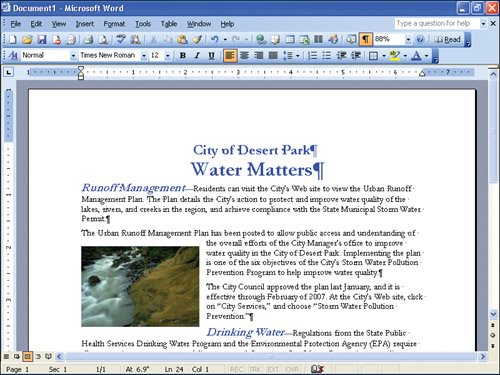
|
|
5. |
Display the Save As dialog box, navigate to the chapter folder in which you are storing your files for this chapter, and then save the document as 4B_Water_Matters_Firstname_Lastname |
|
6. |
Position the insertion point at the end of the paragraph beginning The City Council approved. Press Figure 4.26. 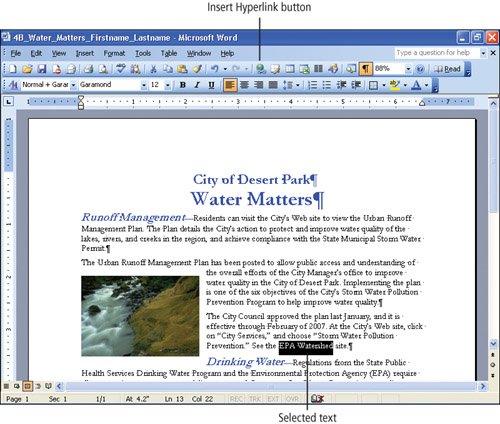
|
|
7. |
On the Standard toolbar, click the Insert Hyperlink button |
|
8. |
In the displayed Insert Hyperlink dialog box, under Link to, click Existing File or Web Page. In the Address box, type http://cfpub.epa.gov/surf/locate/map2.cfm |
|
|
|
|
9. |
In the upper right corner of the Insert Hyperlink dialog box, click ScreenTip. In the Set Hyperlink ScreenTip dialog box, type Watershed Map and then compare your screen with Figure 4.27. Figure 4.27. 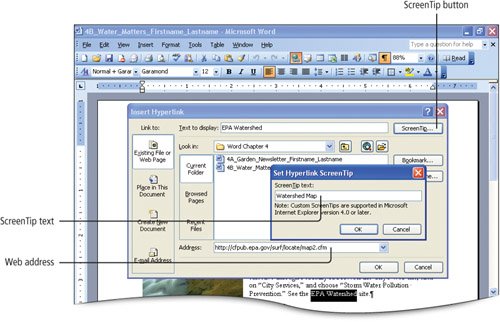
This is the ScreenTip that will display when the pointer is placed over the hyperlink. |
|
10. |
On the Set Hyperlink ScreenTip dialog box, click OK. At the bottom of the Insert Hyperlink dialog box, click OK. |
|
11. |
In the next paragraph, in the second line, select the text Environmental Protection Agency (EPA). Using the technique you just practiced, create a hyperlink to the address http://www.epa.gov and type EPA Home Page as the ScreenTip. Save Figure 4.28. 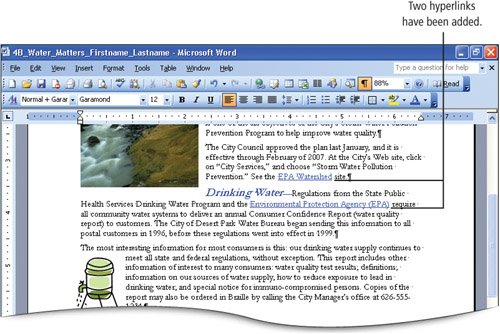
|
Activity 4.11. Adding a Hyperlink to a Graphic
When you point to a graphic on a Web page, if the pointer changes to the Link Select pointer (a pointing finger), this indicates that a hyperlink has been added to the graphic. When you point to a hyperlink in a Word document, a ScreenTip displays with instructions for accessing the link.
|
1. |
Scroll to view the bottom of the document, and then click the water cooler graphic to select it. Display the Insert Hyperlink dialog box, under Link to, be sure Existing File or Web Page is selected, and then create the link to the address http://www.epa.gov As the ScreenTip, type Drinking Water Standards and then compare your screen with Figure 4.29. Figure 4.29. 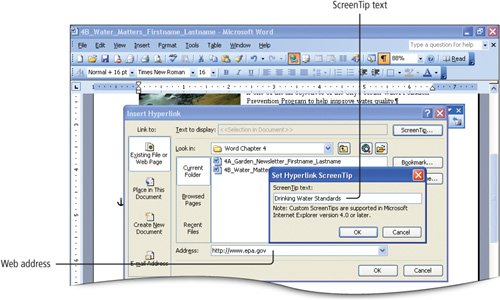
|
|
2. |
Click OK to close the dialog boxes, and click anywhere in the document to deselect the image. Then, point to the water cooler graphic to display the ScreenTip that you typed. Compare your screen with Figure 4.30. Figure 4.30. 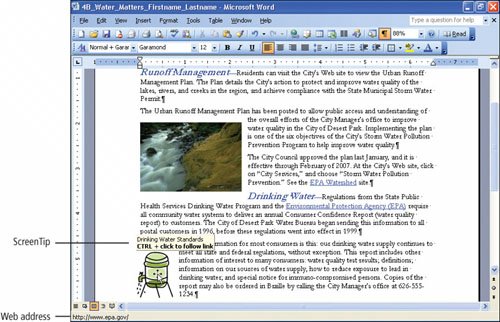
The instructions for activating the hyperlink display in the ScreenTip, and the Web address displays in the status bar. |
|
|
|
|
3. |
Point to the EPA Watershed hyperlink and notice the ScreenTip and the Web address in the status bar. Use the same procedure to check the Environmental Protection Agency (EPA) hyperlink. Save |
More Knowledge: Adding an E-mail Hyperlink
You can also add a hyperlink to an e-mail address in a document. Select the text that you want to link to, and then click the Insert Hyperlink button. Under Link to, click E-mail Address. Type the e-mail address, or select it from the Recently used e-mail addresses list. If desired, type a Subject line. You can also click the ScreenTip button to add a ScreenTip to the hyperlink.
Activity 4.12. Testing and Modifying Hyperlinks
Make changes to hyperlinks from the Edit Hyperlink dialog box, which is similar to the Insert Hyperlink dialog box.
|
1. |
Be sure you have an Internet connection, and be sure the water cooler graphic is not selected. Point to the water cooler graphic and read the ScreenTip. Follow the directions to test the hyperlink. |
|
2. |
Return to your document. Point to the water cooler graphic and right-click. From the shortcut menu, click Edit Hyperlink. At the bottom of the Edit Hyperlink dialog box, in the Address box, add safewater to the end of the Internet address. Compare your dialog box with Figure 4.31. Figure 4.31. 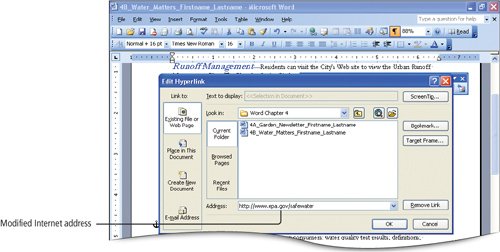
NoteIf the Text Displays Automatically When you begin typing the text in the text boxes of the Edit Hyperlink dialog box, the complete text may display after typing only a few letters. This indicates that another student used the computer to complete this project and that the AutoComplete feature is turned on. |
|
3. |
At the bottom of the Edit Hyperlink dialog box, click OK to change the hyperlink address. Display the Footer area. On the Header and Footer toolbar, click the Insert AutoText button |
|
[Page 522 (continued)] Objective 6 Preview and Save a Document as a Web Page |
Windows XP
- Chapter One. Getting Started with Windows XP
- Project 1A. Windows XP
- Objective 1. Get Started with Windows XP
- Objective 2. Resize, Move, and Scroll Windows
- Objective 3. Maximize, Restore, Minimize, and Close a Window
- Objective 4. Create a New Folder
- Objective 5. Copy, Move, Rename, and Delete Files
- Objective 6. Find Files and Folders
- Objective 7. Compress Files
- Summary
- Key Terms
- Concepts Assessments
Outlook 2003
- Chapter One. Getting Started with Outlook 2003
- Getting Started with Microsoft Office Outlook 2003
- Project 1A. Exploring Outlook 2003
- Objective 1. Start and Navigate Outlook
- Objective 2. Read and Respond to E-mail
- Objective 3. Store Contact and Task Information
- Objective 4. Work with the Calendar
- Objective 5. Delete Outlook Information and Close Outlook
- Summary
- Key Terms
- Concepts Assessments
- Skill Assessments
- Performance Assessments
- Mastery Assessments
- Problem Solving
- GO! with Help
Internet Explorer
- Chapter One. Getting Started with Internet Explorer
- Getting Started with Internet Explorer 6.0
- Project 1A. College and Career Information
- Objective 1. Start Internet Explorer and Identify Screen Elements
- Objective 2. Navigate the Internet
- Objective 3. Create and Manage Favorites
- Objective 4. Search the Internet
- Objective 5. Save and Print Web Pages
- Summary
- Key Terms
- Concepts Assessments
- Skill Assessments
- Performance Assessments
- Mastery Assessments
- Problem Solving
Computer Concepts
- Chapter One. Basic Computer Concepts
- Objective 1. Define Computer and Identify the Four Basic Computing Functions
- Objective 2. Identify the Different Types of Computers
- Objective 3. Describe Hardware Devices and Their Uses
- Objective 4. Identify Types of Software and Their Uses
- Objective 5. Describe Networks and Define Network Terms
- Objective 6. Identify Safe Computing Practices
- Summary
- In this Chapter You Learned How to
- Key Terms
- Concepts Assessments
Word 2003
Chapter One. Creating Documents with Microsoft Word 2003
- Chapter One. Creating Documents with Microsoft Word 2003
- Getting Started with Microsoft Office Word 2003
- Project 1A. Thank You Letter
- Objective 1. Create and Save a New Document
- Objective 2. Edit Text
- Objective 3. Select, Delete, and Format Text
- Objective 4. Create Footers and Print Documents
- Project 1B. Party Themes
- Objective 5. Navigate the Word Window
- Objective 6. Add a Graphic to a Document
- Objective 7. Use the Spelling and Grammar Checker
- Objective 8. Preview and Print Documents, Close a Document, and Close Word
- Objective 9. Use the Microsoft Help System
- Summary
- Key Terms
- Concepts Assessments
- Skill Assessments
- Performance Assessments
- Mastery Assessments
- Problem Solving
- You and GO!
- Business Running Case
- GO! with Help
Chapter Two. Formatting and Organizing Text
- Formatting and Organizing Text
- Project 2A. Alaska Trip
- Objective 1. Change Document and Paragraph Layout
- Objective 2. Change and Reorganize Text
- Objective 3. Create and Modify Lists
- Project 2B. Research Paper
- Objective 4. Insert and Format Headers and Footers
- Objective 5. Insert Frequently Used Text
- Objective 6. Insert and Format References
- Summary
- Key Terms
- Concepts Assessments
- Skill Assessments
- Performance Assessments
- Mastery Assessments
- Problem Solving
- You and GO!
- Business Running Case
- GO! with Help
Chapter Three. Using Graphics and Tables
- Using Graphics and Tables
- Project 3A. Job Opportunities
- Objective 1. Insert and Modify Clip Art and Pictures
- Objective 2. Use the Drawing Toolbar
- Project 3B. Park Changes
- Objective 3. Set Tab Stops
- Objective 4. Create a Table
- Objective 5. Format a Table
- Objective 6. Create a Table from Existing Text
- Summary
- Key Terms
- Concepts Assessments
- Skill Assessments
- Performance Assessments
- Mastery Assessments
- Problem Solving
- You and GO!
- Business Running Case
- GO! with Help
Chapter Four. Using Special Document Formats, Columns, and Mail Merge
- Using Special Document Formats, Columns, and Mail Merge
- Project 4A. Garden Newsletter
- Objective 1. Create a Decorative Title
- Objective 2. Create Multicolumn Documents
- Objective 3. Add Special Paragraph Formatting
- Objective 4. Use Special Character Formats
- Project 4B. Water Matters
- Objective 5. Insert Hyperlinks
- Objective 6. Preview and Save a Document as a Web Page
- Project 4C. Recreation Ideas
- Objective 7. Locate Supporting Information
- Objective 8. Find Objects with the Select Browse Object Button
- Project 4D. Mailing Labels
- Objective 9. Create Labels Using the Mail Merge Wizard
- Summary
- Key Terms
- Concepts Assessments
- Skill Assessments
- Performance Assessments
- Mastery Assessments
- Problem Solving
- You and GO!
- Business Running Case
- GO! with Help
Excel 2003
Chapter One. Creating a Worksheet and Charting Data
- Creating a Worksheet and Charting Data
- Project 1A. Tableware
- Objective 1. Start Excel and Navigate a Workbook
- Objective 2. Select Parts of a Worksheet
- Objective 3. Enter and Edit Data in a Worksheet
- Objective 4. Construct a Formula and Use the Sum Function
- Objective 5. Format Data and Cells
- Objective 6. Chart Data
- Objective 7. Annotate a Chart
- Objective 8. Prepare a Worksheet for Printing
- Objective 9. Use the Excel Help System
- Project 1B. Gas Usage
- Objective 10. Open and Save an Existing Workbook
- Objective 11. Navigate and Rename Worksheets
- Objective 12. Enter Dates and Clear Formats
- Objective 13. Use a Summary Sheet
- Objective 14. Format Worksheets in a Workbook
- Summary
- Key Terms
- Concepts Assessments
- Skill Assessments
- Performance Assessments
- Mastery Assessments
- Problem Solving
- You and GO!
- Business Running Case
- GO! with Help
Chapter Two. Designing Effective Worksheets
- Designing Effective Worksheets
- Project 2A. Staff Schedule
- Objective 1. Use AutoFill to Fill a Pattern of Column and Row Titles
- Objective 2. Copy Text Using the Fill Handle
- Objective 3. Use AutoFormat
- Objective 4. View, Scroll, and Print Large Worksheets
- Project 2B. Inventory Value
- Objective 5. Design a Worksheet
- Objective 6. Copy Formulas
- Objective 7. Format Percents, Move Formulas, and Wrap Text
- Objective 8. Make Comparisons Using a Pie Chart
- Objective 9. Print a Chart on a Separate Worksheet
- Project 2C. Population Growth
- Objective 10. Design a Worksheet for What-If Analysis
- Objective 11. Perform What-If Analysis
- Objective 12. Compare Data with a Line Chart
- Summary
- Key Terms
- Concepts Assessments
- Skill Assessments
- Performance Assessments
- Mastery Assessments
- Problem Solving
- You and GO!
- Business Running Case
- GO! with Help
Chapter Three. Using Functions and Data Tables
- Using Functions and Data Tables
- Project 3A. Geography Lecture
- Objective 1. Use SUM, AVERAGE, MIN, and MAX Functions
- Objective 2. Use a Chart to Make Comparisons
- Project 3B. Lab Supervisors
- Objective 3. Use COUNTIF and IF Functions, and Apply Conditional Formatting
- Objective 4. Use a Date Function
- Project 3C. Loan Payment
- Objective 5. Use Financial Functions
- Objective 6. Use Goal Seek
- Objective 7. Create a Data Table
- Summary
- Key Terms
- Concepts Assessments
- Skill Assessments
- Performance Assessments
- Mastery Assessments
- Problem Solving
- You and GO!
- Business Running Case
- GO! with Help
Access 2003
Chapter One. Getting Started with Access Databases and Tables
- Getting Started with Access Databases and Tables
- Project 1A. Academic Departments
- Objective 1. Rename a Database
- Objective 2. Start Access, Open an Existing Database, and View Database Objects
- Project 1B. Fundraising
- Objective 3. Create a New Database
- Objective 4. Create a New Table
- Objective 5. Add Records to a Table
- Objective 6. Modify the Table Design
- Objective 7. Create Table Relationships
- Objective 8. Find and Edit Records in a Table
- Objective 9. Print a Table
- Objective 10. Close and Save a Database
- Objective 11. Use the Access Help System
- Summary
- Key Terms
- Concepts Assessments
- Skill Assessments
- Performance Assessments
- Mastery Assessments
- Problem Solving Assessments
- Problem Solving
- You and GO!
- Business Running Case
- GO! with Help
Chapter Two. Sort, Filter, and Query a Database
- Sort, Filter, and Query a Database
- Project 2A. Club Fundraiser
- Objective 1. Sort Records
- Objective 2. Filter Records
- Objective 3. Create a Select Query
- Objective 4. Open and Edit an Existing Query
- Objective 5. Sort Data in a Query
- Objective 6. Specify Text Criteria in a Query
- Objective 7. Print a Query
- Objective 8. Specify Numeric Criteria in a Query
- Objective 9. Use Compound Criteria
- Objective 10. Create a Query Based on More Than One Table
- Objective 11. Use Wildcards in a Query
- Objective 12. Use Calculated Fields in a Query
- Objective 13. Group Data and Calculate Statistics in a Query
- Summary
- Key Terms
- Concepts Assessments
- Skill Assessments
- Performance Assessments
- Mastery Assessments
- Problem Solving
- You and GO!
- Business Running Case
- GO! with Access Help
Chapter Three. Forms and Reports
- Forms and Reports
- Project 3A. Fundraiser
- Objective 1. Create an AutoForm
- Objective 2. Use a Form to Add and Delete Records
- Objective 3. Create a Form Using the Form Wizard
- Objective 4. Modify a Form
- Objective 5. Create an AutoReport
- Objective 6. Create a Report Using the Report Wizard
- Objective 7. Modify the Design of a Report
- Objective 8. Print a Report and Keep Data Together
- Summary
- Key Terms
- Concepts Assessments
- Skill Assessments
- Performance Assessments
- Mastery Assessments
- Problem Solving
- You and GO!
- Business Running Case
- GO! with Help
Powerpoint 2003
Chapter One. Getting Started with PowerPoint 2003
- Getting Started with PowerPoint 2003
- Project 1A. Expansion
- Objective 1. Start and Exit PowerPoint
- Objective 2. Edit a Presentation Using the Outline/Slides Pane
- Objective 3. Format and Edit a Presentation Using the Slide Pane
- Objective 4. View and Edit a Presentation in Slide Sorter View
- Objective 5. View a Slide Show
- Objective 6. Create Headers and Footers
- Objective 7. Print a Presentation
- Objective 8. Use PowerPoint Help
- Summary
- Key Terms
- Concepts Assessments
- Skill Assessments
- Performance Assessments
- Mastery Assessments
- Problem Solving
- You and GO!
- Business Running Case
- GO! with Help
Chapter Two. Creating a Presentation
- Creating a Presentation
- Project 2A. Teenagers
- Objective 1. Create a Presentation
- Objective 2. Modify Slides
- Project 2B. History
- Objective 3. Create a Presentation Using a Design Template
- Objective 4. Import Text from Word
- Objective 5. Move and Copy Text
- Summary
- Key Terms
- Concepts Assessments
- Skill Assessments
- Performance Assessments
- Mastery Assessments
- Problem Solving
- You and GO!
- Business Running Case
- GO! with Help
Chapter Three. Formatting a Presentation
- Project 3A. Emergency
- Objective 1. Format Slide Text
- Objective 2. Modify Placeholders
- Objective 3. Modify Slide Master Elements
- Objective 4. Insert Clip Art
- Project 3B. Volunteers
- Objective 5. Apply Bullets and Numbering
- Objective 6. Customize a Color Scheme
- Objective 7. Modify the Slide Background
- Objective 8. Apply an Animation Scheme
- Summary
- Key Terms
- Concepts Assessments
- Skill Assessments
- Performance Assessments
- Mastery Assessments
- Problem Solving
- You and GO!
- Business Running Case
- GO! with Help
Integrated Projects
Chapter One. Using Access Data with Other Office Applications
- Chapter One. Using Access Data with Other Office Applications
- Introduction
- Project 1A. Meeting Slides
- Objective 1. Export Access Data to Excel
- Objective 2. Create a Formula in Excel
- Objective 3. Create a Chart in Excel
- Objective 4. Copy Access Data into a Word Document
- Objective 5. Copy Excel Data into a Word Document
- Objective 6. Insert an Excel Chart into a PowerPoint Presentation
Chapter Two. Using Tables in Word and Excel
- Chapter Two. Using Tables in Word and Excel
- Introduction
- Project 2A. Meeting Notes
- Objective 1. Plan a Table in Word
- Objective 2. Enter Data and Format a Table in Word
- Objective 3. Create a Table in Word from Excel Data
- Objective 4. Create Excel Worksheet Data from a Word Table
Chapter Three. Using Excel as a Data Source in a Mail Merge
- Chapter Three. Using Excel as a Data Source in a Mail Merge
- Introduction
- Project 3A. Mailing Labels
- Objective 1. Prepare a Mail Merge Document as Mailing Labels
- Objective 2. Choose an Excel Worksheet as a Data Source
- Objective 3. Produce and Save Merged Mailing Labels
- Objective 4. Open a Saved Main Document for Mail Merge
Chapter Four. Linking Data in Office Documents
- Chapter Four. Linking Data in Office Documents
- Introduction
- Project 4A. Weekly Sales
- Objective 1. Insert and Link in Word an Excel Object
- Objective 2. Format an Object in Word
- Objective 3. Open a Word Document That Includes a Linked Object, and Update Links
Chapter Five. Creating Presentation Content from Office Documents
EAN: 2147483647
Pages: 448
 . Type Water Matters and then press
. Type Water Matters and then press  to Garamond, and then change the Font Size
to Garamond, and then change the Font Size  to 20. Select the second line of text, change the font to Garamond and the font size to 28.
to 20. Select the second line of text, change the font to Garamond and the font size to 28. , and then click Center
, and then click Center  . Click the Font Color arrow
. Click the Font Color arrow  , and then in the second row, click the sixth colorBlue.
, and then in the second row, click the sixth colorBlue. once and then type See the EPA Watershed site. In the sentence you just typed, select the text EPA Watershed. Compare your screen with Figure 4.26.
once and then type See the EPA Watershed site. In the sentence you just typed, select the text EPA Watershed. Compare your screen with Figure 4.26. . Alternatively, right-click on the selected text and click Hyperlink from the shortcut menu; or, select Hyperlink from the Insert menu.
. Alternatively, right-click on the selected text and click Hyperlink from the shortcut menu; or, select Hyperlink from the Insert menu. your document, and then compare your screen with Figure 4.28.
your document, and then compare your screen with Figure 4.28. and click the hyperlink.
and click the hyperlink. , and then click Filename. Close
, and then click Filename. Close  the footer, and then Save
the footer, and then Save 